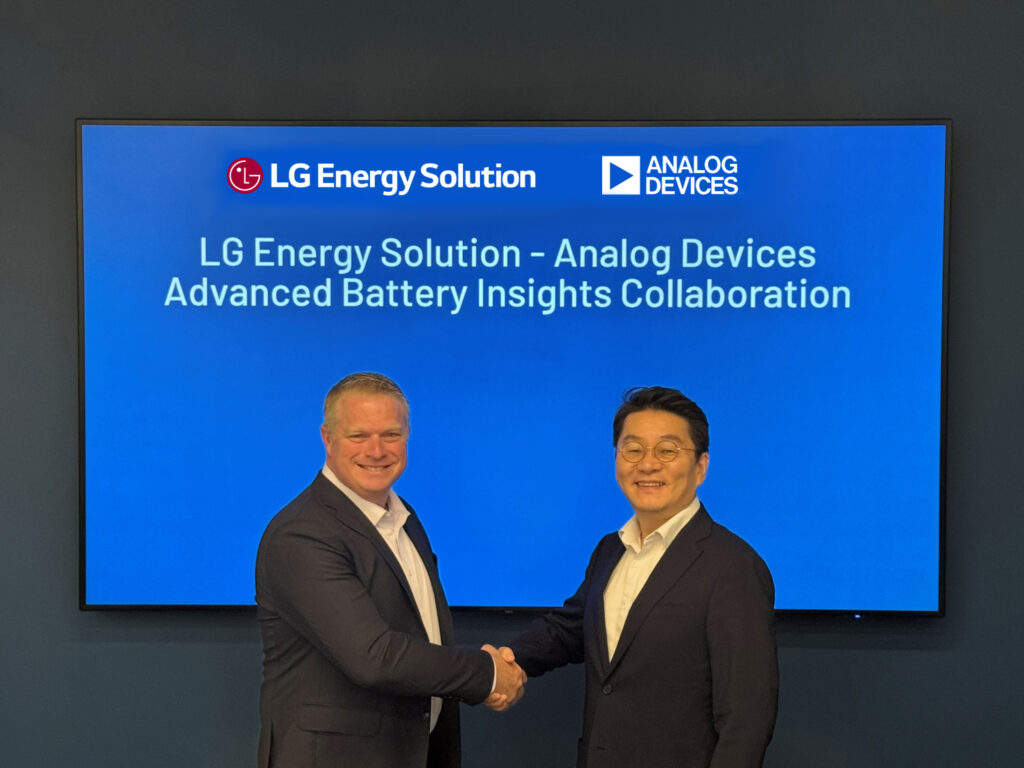ASIA ELECTRONICS INDUSTRYYOUR WINDOW TO SMART MANUFACTURING
LG Energy, Analog Devices Enter in New Battery Deal
LG Energy Solution has signed a Memorandum of Understanding (MoU) with Analog Devices, Inc. (ADI) to strengthen the competitiveness of its battery management total solution (BMTS).
Through the MoU, the companies have agreed on a two-year joint effort. Specifically, ADI will supply high-performance battery management integrated circuit (BMIC). Additionally, the two companies will co-develop algorithms that could precisely measure the internal temperatures of EV battery cells. Accordingly, this could lead to the development of advanced fast-charging technologies.

Focus on Sustainable Energy
ADI is a well-known technology leader that has a large focus on sustainable energy. The company also has a broad product portfolio, including advanced technologies in impedance measurement.
In electrical science literature, impedance is the opposition of an electrical component to alternating current and voltage in a circuit. Electrochemical Impedance Spectroscopy (EIS) is the technology that measures it at different frequencies.
Particularly, ADI EIS solutions utilize first-in-the-market BMIC to accurately measure the impedance at controlled frequencies. Since the impedance varies based on the battery’s state, age, and temperature, its exact measurement leads to a deep understanding and diagnosis of its internal conditions.
EIS Solutions Estimate Internal Temperature of Batteries
In a conventional battery management system, a separate temperature measurement device is attached to the exterior of a battery cell. Once it obtains information, the BMIC manages it. Primarily, traditional devices cannot measure the exact temperature inside an individual battery cell in real time. Thus, a battery’s safe charging temperature must be set to a conservative number. Accordingly, it limits opportunities to further enhance charging speeds.
EIS solutions address these limitations. Specifically, it precisely estimates the internal temperature of individual battery cells without the need for a separate temperature measuring device. Thus, it opens the door for improving charging speeds. In addition, these solutions could to contribute to improving battery performance and longevity. Particularly, they will enhance the safety of fast charging and accurately assess the charging and general status of the batteries.
While it is used primarily to analyze defects in used batteries, the technology is yet to be commercialized. Although, many research institutions are investigating its application to EV batteries. If successful, the joint effort between LG Energy Solution and ADI would be the innovative case of applying a real-time impedance measurement case to analyzing EV batteries’ internal status.
Additionally, LG Energy Solution plans to integrate its accumulated battery manufacturing and BMS capabilities with ADI’s advanced impedance measurement technology to further enhance its BMTS and deliver additional customer value.
“The joint effort with ADI, which has an innovative BMIC portfolio, will further strengthen the capabilities of LG Energy Solution’s battery management solution,” said Dalhoon Lee, Vice President and head of the BMS R&D Center at LG Energy Solution.
“Through this joint effort, we will continue to enhance LG Energy Solution’s technological prowess and deliver differentiated value to our customers.”
Roger Keen, General Manager, Battery Management at ADI said, “ADI’s electrochemical impedance spectroscopy (EIS) technology is a leader in the industry for the in-application use of this amazingly insightful measurement for battery management applications.”
“Our joint effort with LG Energy Solution furthers the contribution ADI has been bringing to the energy transition. We are enthusiastic to keep working together with LG Energy Solution to bring state-of-the-art and efficient batteries to the market, and to further advance the clean energy ecosystem,” Keen continued.
-05 June 2024-




